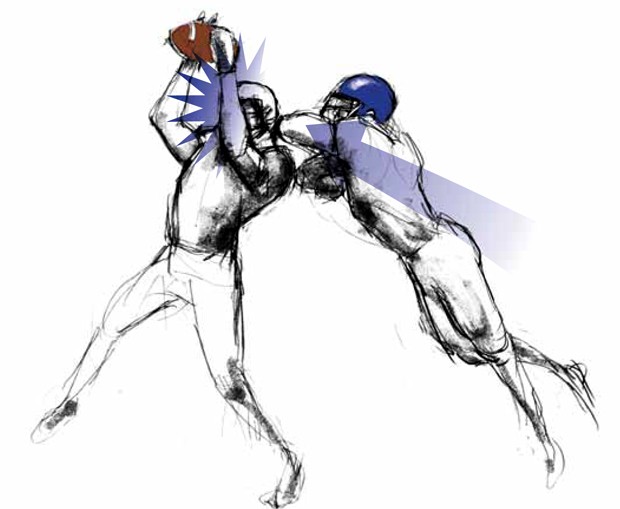The video has been watched more than seven and a half million times: Heavy metal drums pound in the background as Georgia wide receiver Reggie Brown receives a pass, and turns up field. Waiting for him is AuburnâÄôs Junior Rosegreen, who propels himself violently into Brown, who fumbled the ball. Moments after, the camera shows Brown lying on the field, motionless, an announcer is heard saying âÄúThis was a great hit.âÄù Not anymore. The 2004 hit, which is now a popular Youtube video, was later cited as an example when the NCAA began to look closer at helmet to helmet hits. Indeed, Ron Courson, the Georgia trainer who attended to Brown, headed a task force which helped to strengthen the existing rule on head down hits. Now, the rule is even stronger. In the last five years, the NCAA has enacted a series of regulations in an attempt to cut down on illegal helmet to helmet hits, referred to as âÄúspearing.âÄù These hits, where a player lowers his head and propels himself into another player, are often dangerous and sometimes fatal, both to the player receiving and the one delivering the hit. In February, the NCAA supplemented the existing rules which govern illegal hits. The NCAA Football Rules Committee first encouraged referees to more frequently eject players who have violated the rule. This season, illegal hits will undergo a mandatory review by the offending playerâÄôs conference, which may then choose to suspend the player. A further regulation, one which is troubling to some coaches, allows the conference to review plays which were not even signaled as a foul during the game. âÄúThatâÄôs a little unsettling, to me,âÄù says Michigan State head coach Mark Dantonio . âÄúYouâÄôd think that if the officials didnâÄôt see it as a flagrant hit, that it wouldnâÄôt be called after the fact.âÄù Both Dantonio and MichiganâÄôs Rich Rodriguez expressed some trepidation about the conference reviews while enthusiastically supporting any effort to keep players safe. Dantonio and Rodriguez both said Big Ten officials visited their teams before the season and played video examples of hits which are illegal. Players say knowing the rule is one thing, but following procedure in the heat of the game is another. âÄúYouâÄôre not going to lead with your head all the time, but if you make a little helmet to helmet contact, you just hope you donâÄôt get in trouble for it,âÄù Gophers linebacker Simoni Lawrence said. âÄúYouâÄôre just trying to play football; youâÄôre not trying to hurt anybody.âÄù The review process can be set off by a tip from a coach, referee or someone inside the Big Ten office. Bill Carollo, the Big Ten coordinator of football officials and a 20 year veteran as an NFL referee, said while the suggested penalty for an illegal hit is one game, technically there is no upper limit on the length of suspensions. But Carollo said a suspension will only come on those plays which go well beyond the bounds of football. âÄúWhere I would say intentional would be, the playâÄôs over, and the guy totally spears the guy helmet to helmet, launches with the crown of his helmet,âÄù Carollo said. âÄúThatâÄôs intentional, thatâÄôs targeting. ThatâÄôs trying to punish, and to me thatâÄôs black and white.âÄù Minnesota Head Football Trainer Ed Lochrie said that he deals almost constantly with players who have minor injuries to their neck or shoulder from tackling and said that kind of damage is inevitable. âÄúYouâÄôve got a 200 pound, 250 pound guy running full speed at another guy thatâÄôs running 250 pounds, and yeah thereâÄôs quite a bit of force generated with that,âÄù Lochrie said. âÄúItâÄôs pretty amazing to be down on the sideline and watch how much force and how fast the game is played.âÄù Lochrie and his trainers have practiced all the steps for a worst case scenario. They know how to call for the ambulance and how to gently remove a playerâÄôs helmet. They know how to secure him to a backboard, and lift him into an ambulance, which will drive the player directly from the field to an emergency room for a potentially lifesaving procedure. In his seven years as MinnesotaâÄôs head football trainer, however, Lochrie said he has never had to put this training into practice and he never wants to.
NCAA cracks down on dangerous hits
New rules could see suspensions for players who lead with their helmet.

by Mike Mullen
Published September 9, 2009
0

